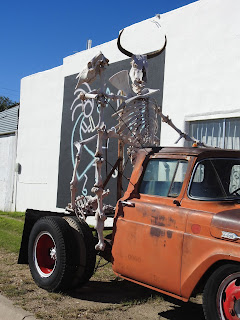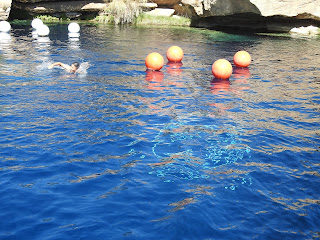The Hawthornes are back on Route 66, heading through New Mexico.
We stopped along the way in Tucumcari.
Color me enchanted.
I think I'll save this picture for the Hawthornes' Christmas card.
Once again, the Hawthornes find themselves at odds with one another.
Next, we stopped at the Santa Rosa Blue Hole.
What is the Santa Rosa Blue Hole, you ask?
The Blue Hole is one of seven sister lakes
connected underground by a vast system of water.
Back in the days of nomadic tribes, cowboys,
and Americans motoring down the "Mother Road,"
it was a destination - a place of respite.
In 1932, it became a national fish hatchery.
Now, it's more than just a watering hole.
It's a recreation and conference center,
and a highly popular dive destination.
The Blue Hole, in the midst of the desert, surrounded by red mesas, is the geological product of a phenomenon called the Santa Rosa Sink. The Santa Rosa Sink was formed over millions of years. Erosion and water seepage created a large basin and wetlands. Constant water action weakened and dissolved the geological strata, resulting in its subsequent collapse. The dynamic combination of water erosion from below and standing water pressure from above created the water-filled geological phenomenon of a large sinkhole.Blue Hole is a large sinkhole (along with Hidden Lake, Twin Lakes, Perch Lake, Bass Lake, Post Lake or Swan Lake, and Rock Lake), developed by an underground aquifer and caverns. It is a natural spring fed lake with an outflow of about 3000 gallons per minute. The constant spring flow of this crystal clear artesian well keeps the water temperature at a constant 61 degrees. The surface is 80 feet in diameter, expanding to 130 feet in diameter at the bottom. Due to the fact that the water completely renews itself every six hours, visibility is an astounding 100 feet.
Permits are required for divers, with about 8000 issued annually. Blue Hole is a high-altitude dive and special consideration must be given to the additional atmospheric pressure due to Santa Rosa's altitude. The condition called the "bends" is less forgiving at high altitudes and divers are advised to stay overnight and delay getting immediately back on the road due to this threat.
Even seasoned divers have lost their lives in the Blue Hole. In Spring 2016, Shane Thompson, a deep sea diver and Navy vet, was exploring the caverns beneath the Blue Hole and died after getting trapped while navigating the underwater labyrinth. Thompson was part of a two-person dive team who got rare access to the caves in an effort to map out the caverns and make them more accessible. An expert diver, Thompson, along with his diving partner, entered a narrow chamber about 194 feet deep, with no visibility due to the silt. He lost sight of his diving partner, became unconnected from their cord, got disoriented inside the narrow passageways, became trapped in an unmapped are of the caverns, and was later found dead. Thomas' dive partner, Mike Young, told authorities the caverns should be sealed for good after his friend's death. He considered them "the most dangerous caves they've ever dived anywhere."
All cave passages have been explored and mapped. The main water source for the blue hole is filtering up through tons of rock debris at the end of the deepest passage (194 feet). Due to extreme restrictions and high silt conditions, the cave system has been sealed for further exploration.
Back on the road.
Enjoy the views to Albuquerque.
I won't tell you Mr. Hawthorne's name for this particular mountain.




















































































No comments:
Post a Comment